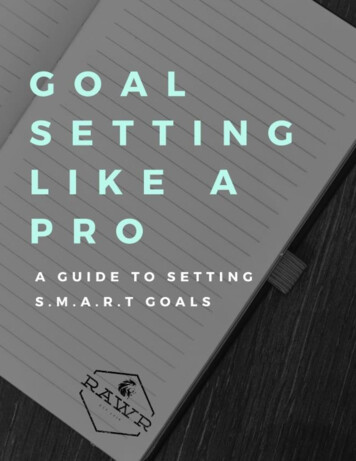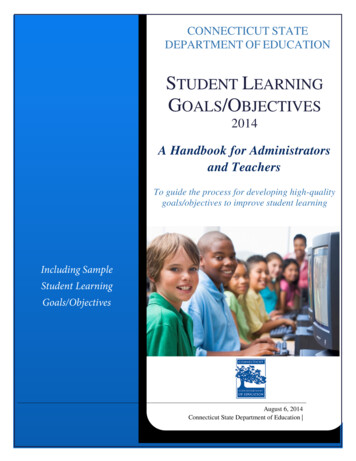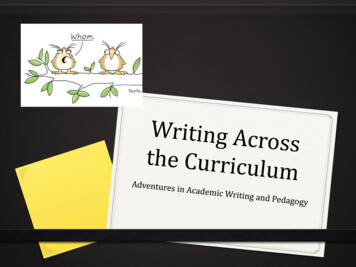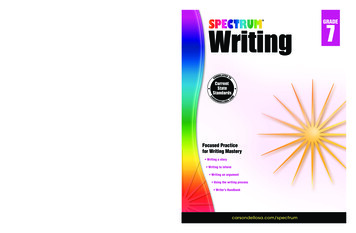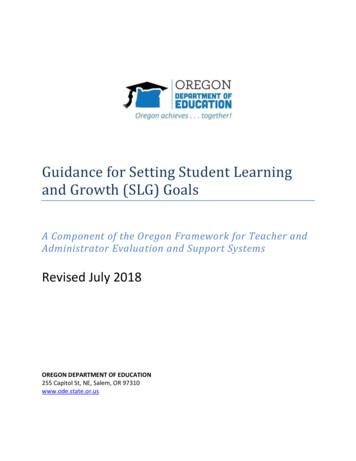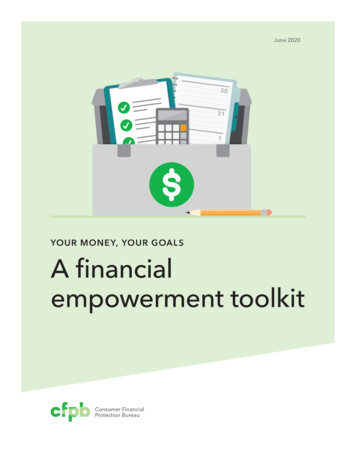
Transcription
StudentWritingGoalsK-12 Writing -GoalsOregon K-12 Literacy Framework—Writing (Writing Framework)Writing goals that focus on students’ fluency, productivity, writing quality,and use of the writing process to write multiple forms of text across thecontent areas—anchor a school’s comprehensive writing plan.Setting and Meeting Measurable Writing Goals aligned to the Common Core:Producing: A critical school responsibility is ensuring K-12 students develop theskills to write fluently, so they are able produce the amount (and quality) of writingnecessary to complete school assignments and other academic tasks. Specifically,fluent handwriting, keyboarding, spelling, vocabulary use, and language use (e.g.,grammar, mechanics, conventions, sentence building knowledge) are essential forproficient, fluent writing.Adapting written communication: A primary writing goal across K-12 is thatstudents must adapt their written communication to audience, task, purpose, anddiscipline, and apply the conventions associated with different writing genres.Specifically, students must develop proficiency with argument,informational/explanatory, and narrative writing in the CCSS.Developing coherent written products using the writing process: K-12students use all aspects of the writing process (e.g., plan, organize, write, edit,revise) to produce high quality, coherent writing.
GOALS — WritingWriting to Learn: K-12 students must use writing to think and learn (e.g., writing tolearn, writing in the content areas), respond to reading tasks (e.g., use of writtensummarization, writing comprehension questions for class discussion), and researchand build knowledge (e.g., research projects and data gathering).Writing routinely: K-12 students must write frequently and regularly over extendedand shorter timeframes.K-12 Writing Goals and the Common CoreMeeting or exceeding grade-level formative and summative writing goals means that students havemet the Common Core State Standards (CCSS) expectations for writing knowledge and skills. Specifically,students must write fluently and productively; write for a variety of purposes (e.g., multiple text types) andaudiences; purposefully engage in each step of the writing process; demonstrate their ability to incorporatethe mechanics of good writing in each written text they produce (e.g., writing quality); use writing to learn;and spend instructional time writing. Not meeting grade-level formative and summative writing goalsmeans that students need additional instructional support designed to improve their opportunities to meetgrade level goals aligned to the CCSS.K-12 CCSS Anchor Standards for Writing: The ―What‖ of WritingText Types and Purposes (and subgenres)1. Write arguments to support claims in an analysis of substantive topics or texts, using validreasoning and relevant and sufficient evidence.2. Write informative/explanatory texts to examine and convey complex ideas and information clearlyand accurately through the effective selection, organization, and analysis of content.3. Write narratives to develop real or imagined experiences or events using effective technique, wellchosen details, and well-structured event sequences.Production and Distribution of Writing4. Produce clear and coherent writing in which the development, organization, and style areappropriate to task, purpose, and audience.5. Develop and strengthen writing as needed by planning, revising, editing, rewriting, or trying a newapproach.6. Use technology, including the Internet, to produce and publish writing and to interact andcollaborate with others.Research to Build and Present Knowledge7. Conduct short as well as more sustained research projects based on focused questions,demonstrating understanding of the subject under investigation.8. Gather relevant information from multiple print and digital sources, assess the credibility andaccuracy of each source, and integrate the information while avoiding plagiarism.9. Draw evidence from literacy or informational texts to support analysis, reflection, and research.OREGON LITERACY PLANOregon K-12 Literacy Framework — WritingDeveloped by the Literacy Leadership State Team (LLST) in partnership with the Oregon Department of Education (ODE)WG-2
GOALS — WritingRange of Writing10. Write routinely over extended time frames (time for research, reflection, and revision) and shortertime frames (a single sitting or a day or two) for a range of tasks, purposes, and audiences.Early and Comprehensive Writing Instruction across K-12Students become proficient writers when they communicate their ideas, thoughts, and opinionseffectively. Proficiency can be achieved by providing students with explicit writing instruction andopportunities to practice the writing process (e.g., planning, drafting, revising, and editing) across multipletext types, content areas, and forms of writing beginning in kindergarten and continuing across the K12 grade span. Students who receive strong writing support on the Common Core State Standards(CCSS) for Writing, beginning in early elementary, will be able to meet grade-level writing goals, experiencesuccess throughout school as proficient writers, demonstrate proficiency in writing to earn an Oregondiploma, and be college and career-ready—without the need for writing remediation. The CCSS describe―What‖ writing skills students need at each grade level and K-12 Writing describes ―How‖ schools cansupport all students to meet CCSS Writing expectations. Effective written communication requires languageuse, vocabulary use, and high levels of content understanding.Significant challenges, however, face students who struggle to become proficient writers. At theelementary school level, for example, students who struggle to acquire and demonstrate writingproficiency are likely to earn lower grades, particularly in classes where writing is the primary means ofevaluating student skills and knowledge (Cutler & Graham, 2008; Graham, Harris, & MacArthur, 2004). Inaddition, older students who fail to develop strong writing skills are ―unlikely to realize their occupational orpersonal potential,‖ (Graham, Harris, & Olinghouse, 2007) as evidenced by recent survey data fromemployers.For any K-12 student, learning to write can be challenging. Writing is a demanding cognitive process,further complicated by the iterative nature of the writing process. For example, we write about what weread, and we read what we write. From a writing perspective, a writer needs to wear multiple hats, knowwhen to change hats, and even understand how to wear some hats simultaneously (Gleason, 1995).Each hat represents a different component of cognitive processing during the writing process, and each hatrequires a different set of skills and strategies. For example, writers need to be Thinkers and Organizers.When wearing the Thinker–Organizer hat, the writer determines purpose, anticipates audience, gathersinformation and sources of evidence, generates ideas, translates ideas, and mentally organizes content.When the writer is wearing the Author hat, he or she organizes the thinker’s ideas, generates written ideas,and communicates with an audience. As the Author, the writer also fluently produces text while the Thinkercomposes. As the Reader, the writer builds coherence from what is read, obtains new ideas, and tells theEditor what to edit. Finally, with the Editor hat, the writer hand-writes or types, punctuates, capitalizes, andindents. The Editor also communicates with the Thinker-Organizer, Reader, and Author about revisionsrelated to the text’s purpose, content, and ideas. Writing instruction aligned to the Common Core StateStandards (CCSS) introduces these writing ―roles‖ at grade-appropriate levels, building college and careerready writing skills of integrated cognitive tasks (―hats‖) during a 13-year process.Writing is also complex because writing communicates. In other words, writing is deeplyexpressive with profound thought-provoking potential. It is not just writing; rather, it is also about therelationship, or written conversation, that is created among readers and other writers. Because writing isOREGON LITERACY PLANOregon K-12 Literacy Framework — WritingDeveloped by the Literacy Leadership State Team (LLST) in partnership with the Oregon Department of Education (ODE)WG-3
GOALS — Writingcommunication, it is inherently a social or communal act (Goldberg, 2010). Writing skills, therefore, aresocially critical. The ability to write allows the communication of knowledge and ideas, and providesopportunities to articulate a perspective and persuade others (Graham, et al., 2004). Not unexpectedly,students who struggle with writing are limited in self-expression and are often at a disadvantage whencommunicating with others (Graham, et al., 2004; Penner-Williams, Smith, & Gartin, 2009).Given the cognitive and social complexities inherent in the writing process, research indicatesthat waiting until later grades to begin formal writing instruction and address student challengescan be very problematic and that many difficulties students experience are likely to be ameliorated byearly instruction (Cutler & Graham, 2008). At the secondary school level, for example, writing is the ―majormeans by which students demonstrate their knowledge in school, and the primary instrument that teachersuse to evaluate academic performance‖ (Graham, et al., 2004). And many of the problems that studentsexperience in writing in secondary settings have their antecedents in the early grades. Instructing andintervening early in writing is not only a scientifically validated approach, it is also extremely cost effective.According to a national survey conducted by the National Commission on Writing (2004), strongwriting skills are a critical component of professional opportunities: those who cannot write andcommunicate clearly are unlikely to be hired, and if they are hired, they are unlikely to remain in theirposition long enough to be considered for promotion. As a result, the ability to write proficiently is aneconomic imperative (Juzwik, et al., 2006). Moreover, there is also an increased importance placed onknowledge and information in today’s ―knowledge economy,‖ most of which is communicated throughwriting (Brandt, 2005). With an increased emphasis of proficient writing required for success in fiscal andknowledge economies, there is a corresponding increased demand on schools to prepare students to writewell for numerous purposes and audiences (National Council of Teachers on English, 1991).Reflecting the increased demands for proficient writing skills, and writing’s inherent complexity, writinginstruction should begin as soon as students enter school (Cutler & Graham, 2008; Graham, et al., 2004).Although the focus of writing instruction will shift across the grades as students’ knowledge and writing skillsdevelop, providing explicit, exemplary, and continuous writing instruction across K-12 helps (a) maximizestudents’ writing development (Graham, et al., 2004). The Common Core State Standards for Writing andLanguage K-5 and 6-12 English Language Arts, and the 6-12 Writing Standards for Literacy inHistory/Social Studies, Science, and Technical Subjects emphasize the importance of explicit writinginstruction from early elementary school through the end of high school across all subjects.Summative Writing Goals Anchor Writing InstructionStudents who are college and career-ready in writing and language are fluent, productive, and proficientwriters. College and career-ready students have mastered the Writing and Language Common Core StateStandards (CCSS) and are able to write independently; convey strong content knowledge in writing;respond to the varying demands of audience, task, purpose, and discipline; comprehend and write thoroughcritiques; value and use relevant evidence; use technology and digital media strategically and capably forwritten expression; and use writing to convey an understanding of different perspectives and cultures(CCSS, Introduction, p. 7).The Common Core College and Career-ready (CCR) Anchor Standards for Writing specify what collegeand career-ready students should be able to do as writers by the end of grade 12. To ensure all studentsgraduate from high school college and career-ready, the CCSS include grade-specific, summative goals forOREGON LITERACY PLANOregon K-12 Literacy Framework — WritingDeveloped by the Literacy Leadership State Team (LLST) in partnership with the Oregon Department of Education (ODE)WG-4
GOALS — WritingK-12, directly corresponding by number to each CCR Anchor Standard. In other words, each grade-specificstandard translates the broader CCR goal into a grade-appropriate, summative expectation (for additionalinformation on the CCSS design, see ‖K-12 Teachers: Building Comprehension in the Common Core,‖ pp.R-36-38, Oregon Literacy Plan).The following example illustrates how the first, grade-specific CCSS for Writing at every grade level(from ELA K-5 and 6-12, and 6-12 Literacy for History/Social Studies, Science, and Technical Subjects for6-12) aligns with the first CCR Anchor Standard for Writing, ―Write arguments to support claims in ananalysis of substantive topics or texts, using valid, reasoning and relevant and sufficient evidence.‖ Noticehow each grade-specific standard represents a progressive, developmental interpretation of the first CCRWriting Standard. Starting in kindergarten, for example, students should use a combination of drawing,dictating, and writing to compose opinion pieces (e.g., tell what you liked and/or didn’t like about a book, theweather, lunch, etc.) by the end of the school year. Also note how the written argument builds in complexityacross grade levels. By grades 11/12, students are expected to write arguments that include precise,knowledgeable claim(s) and counterclaims; relevant evidence for both claims and counterclaims; arecognition of the audience’s knowledge level, concerns, values, and possible ideas; words, phases, andclauses as well as varied syntax; a formal style and objective tone while attending to the norms andconventions of the discipline in which they are writing; and a concluding statement or section that followsform and supports the argument presented. See the Grade 11/12 Standard in the following table for theentire outline of what Grade 11/12 students should include in their written arguments for English LanguageArts and also for Literacy in History/Social Studies, Science, and Technical Subjects.CCR Anchor Standard for Writing: Text Types and Purposes1. Write arguments to support claims in an analysis of substantive topics or texts,using valid reasoning and relevant and sufficient evidence.WritingKindergarten1.Use a combination of drawing, dictating, and writing to compose opinionCCSS forpieces in which they tell a reader the topic or the name of the book they areK-5 ELAwriting about and state an opinion or preference about the topic or book (e.g.,My favorite book is. . .).First1.Write opinion pieces in which they introduce the topic or name the book theyare writing about, state an opinion, supply a reason for the opinion, andprovide some sense of closure.Second1.Write opinion pieces in which they introduce the topic or book they are writingabout, state an opinion, supply reasons that support the opinion, use linkingwords (e.g., because, and, also) to connect opinion and reasons, and providea concluding statement or section.Third1.Write opinion pieces on topics or texts, supporting a point of view withreasons.a. Introduce the topic or text they are writing about, state an opinion, andcreate an organizational structure that lists reasons.OREGON LITERACY PLANOregon K-12 Literacy Framework — WritingDeveloped by the Literacy Leadership State Team (LLST) in partnership with the Oregon Department of Education (ODE)WG-5
GOALS — WritingCCR Anchor Standard for Writing: Text Types and Purposes1. Write arguments to support claims in an analysis of substantive topics or texts,using valid reasoning and relevant and sufficient evidence.b. Provide reasons that support the opinion.c.Use linking words and phrases (e.g., because, therefore, since, forexample) to connect opinion and reasons.d. Provide a concluding statement or section.Fourth1.Write opinion pieces on topics or texts, supporting a point of view withreasons and information.a. Introduce a topic or text clearly, state an opinion, and create anorganizational structure in which related ideas are grouped to support thewriter’s purpose.b. Provide reasons that are supported by facts and details.c.Link opinion and reasons using words and phrases (e.g., for instance, inorder to, in addition).d. Provide a concluding statement or section related to the opinionpresented.Fifth1.Write opinion pieces on topics or texts, supporting a point of view withreasons and information.a. Introduce a topic or text clearly, state an opinion, and create anorganizational structure in which ideas are logically grouped to supportthe writer’s purpose.b. Provide logically ordered reasons that are supported by facts and details.c.Link opinion and reasons using words, phrases, and clauses (e.g.,consequently, specifically).d. Provide a concluding statement or section related to the opinionpresented.WritingSixth GradeCCSS for 612 ELA1.Write arguments to support claims with clear reasons and relevant evidence.a. Introduce claim(s) and organize the reasons and evidence clearly.b. Support claim(s) with clear reasons and relevant evidence, using crediblesources and demonstrating an understanding of the topic or text.c.Use words, phrases, and clauses to clarify the relationships amongclaim(s) and reasons.d. Establish and maintain a formal style.OREGON LITERACY PLANOregon K-12 Literacy Framework — WritingDeveloped by the Literacy Leadership State Team (LLST) in partnership with the Oregon Department of Education (ODE)WG-6
GOALS — WritingCCR Anchor Standard for Writing: Text Types and Purposes1. Write arguments to support claims in an analysis of substantive topics or texts,using valid reasoning and relevant and sufficient evidence.e. Provide a concluding statement or section that follows from the argumentpresented.Seventh1.GradeWrite arguments to support claims with clear reasons and relevant evidence.a. Introduce claim(s), acknowledge alternate or opposing claims, andorganize the reasons and evidence logically.b. Support claim(s) with logical reasoning and relevant evidence, usingaccurate, credible sources and demonstrating an understanding of thetopic or text.c.Use words, phrases, and clauses to create cohesion and clarify therelationships among claim(s), reasons, and evidence.d. Establish and maintain a formal style.e. Provide a concluding statement or section that follows from and supportsthe argument presented.Eighth Grade1. Write arguments to support claims with clear reasons and relevant evidence.a. Introduce claim(s), acknowledge and distinguish the claim(s) fromalternate or opposing claims, and organize the reasons and evidencelogically.b. Support claim(s) with logical reasoning and relevant evidence, usingaccurate, credible sources and demonstrating an understanding of thetopic or text.c.Use words, phrases, and clauses to create cohesion and clarify therelationships among claim(s), counterclaims, reasons, and evidence.d. Establish and maintain a formal style.e. Provide a concluding statement or section that follows from and supportsthe argument presented.Ninth-TenthGrades1.Write arguments to support claims in an analysis of substantive topics ortexts, using valid reasoning and relevant and sufficient evidence.a.Introduce precise claim(s), distinguish the claim(s) from alternate oropposing claims, and create an organization that establishes clearrelationships among claim(s), counterclaims, reasons, and evidence.b.OREGON LITERACY PLANDevelop claim(s) and counterclaims fairly, supplying evidence for eachOregon K-12 Literacy Framework — WritingDeveloped by the Literacy Leadership State Team (LLST) in partnership with the Oregon Department of Education (ODE)WG-7
GOALS — WritingCCR Anchor Standard for Writing: Text Types and Purposes1. Write arguments to support claims in an analysis of substantive topics or texts,using valid reasoning and relevant and sufficient evidence.while pointing out the strengths and limitations of both in a manner thatanticipates the audience’s knowledge level and concerns.c.Use words, phrases, and clauses to link the major sections of the text,create cohesion, and clarify the relationships between claim(s) andreasons, between reasons and evidence, and between claim(s) andcounterclaims.d.Establish and maintain a formal style and objective tone while attendingto the norms and conventions of the discipline in which they are writing.e.Provide a concluding statement or section that follows from and supportsthe argument presented.Eleventh-1.TwelfthWrite arguments to support claims in an analysis of substantive topics ortexts, using valid reasoning and relevant and sufficient evidence.Gradesa.Introduce precise, knowledgeable claim(s), establish the significance ofthe claim(s), distinguish the claim(s) from alternate or opposing claims,and create an organization that logically sequences claim(s),counterclaims, reasons, and evidence.b.Develop claim(s) and counterclaims fairly and thoroughly, supplying themost relevant evidence for each while pointing out the strengths andlimitations of both in a manner that anticipates the audience’s knowledgelevel, concerns, values, and possible biases.c.Use words, phrases, and clauses as well as varied syntax to link themajor sections of the text, create cohesion, and clarify the relationshipsbetween claim(s) and reasons, between reasons and evidence, andbetween claim(s) and counterclaims.d.Establish and maintain a formal style and objective tone while attendingto the norms and conventions of the discipline in which they are writing.e.Provide a concluding statement or section that follows from and supportsthe argument presented.WritingSixth-EighthCCSS for 6-Grades12 LiteracyinHistory/SS,Science,1.Write arguments focused on discipline-specific content.a. Introduce claim(s) about a topic or issue, acknowledge anddistinguish the claim(s) from alternate or opposing claims, andorganize the reasons and evidence logically.b. Support claim(s) with logical reasoning and relevant, accurate dataand Tech.and evidence that demonstrate an understanding of the topic orSubjectstext, using credible sources.OREGON LITERACY PLANOregon K-12 Literacy Framework — WritingDeveloped by the Literacy Leadership State Team (LLST) in partnership with the Oregon Department of Education (ODE)WG-8
GOALS — WritingCCR Anchor Standard for Writing: Text Types and Purposes1. Write arguments to support claims in an analysis of substantive topics or texts,using valid reasoning and relevant and sufficient evidence.c.Use words, phrases, and clauses to create cohesion and clarify therelationships among claim(s), counterclaims, reasons, andevidence.d. Establish and maintain a formal style.e. Provide a concluding statement or section that follows from andsupports the argument presented.Ninth-Tenth1.GradesWrite arguments focused on discipline-specific content.a.Introduce precise claim(s), distinguish the claim(s) from alternate oropposing claims, and create an organization that establishes clearrelationships among the claim(s), counterclaims, reasons, andevidence.b.Develop claim(s) and counterclaims fairly, supplying data andevidence for each while pointing out the strengths and limitations ofboth claim(s) and counterclaims in a discipline-appropriate form andin a manner that anticipates the audience’s knowledge level andconcerns.c.Use words, phrases, and clauses to link the major sections of thetext, create cohesion, and clarify the relationships between claim(s)and reasons, between reasons and evidence, and between claim(s)and counterclaims.d.Establish and maintain a formal style and objective tone whileattending to the norms and conventions of the discipline in whichthey are writing.e.Provide a concluding statement or section that follows from orsupports the argument presented.EleventhTwelfthGrades1.Write arguments focused on discipline-specific content.a.Introduce precise, knowledgeable claim(s), establish thesignificance of the claim(s), distinguish the claim(s) from alternate oropposing claims, and create an organization that logicallysequences the claim(s), counterclaims, reasons, and evidence.b.Develop claim(s) and counterclaims fairly and thoroughly, supplyingthe most relevant data and evidence for each while pointing out thestrengths and limitations of both claim(s) and counterclaims in adiscipline-appropriate form that anticipates the audience’sOREGON LITERACY PLANOregon K-12 Literacy Framework — WritingDeveloped by the Literacy Leadership State Team (LLST) in partnership with the Oregon Department of Education (ODE)WG-9
GOALS — WritingCCR Anchor Standard for Writing: Text Types and Purposes1. Write arguments to support claims in an analysis of substantive topics or texts,using valid reasoning and relevant and sufficient evidence.knowledge level, concerns, values, and possible biases.c.Use words, phrases, and clauses as well as varied syntax to link themajor sections of the text, create cohesion, and clarify therelationships between claim(s) and reasons, between reasons andevidence, and between claim(s) and counterclaims.d.Establish and maintain a formal style and objective tone whileattending to the norms and conventions of the discipline in whichthey are writing.e.Provide a concluding statement or section that follows from orsupports the argument presented.Setting Measurable Writing Goals Aligned to the Common CoreIn this section the five fundamental and measurable goals are described with the applicable CommonCore CCR Anchor Standards linked to each goal. Several CCR Anchor Standards overlap and are listedacross several goals. The overlap is intentional and represents the integrated approach to instructionposited by the CCSS. The descriptive text for each goal provides a preview as well as an overview of thecontent presented in the remaining K-12 Writing chapters. To help with the first step of implementation—,development of District and School Writing Plans based on the goals—, planning notes are included foreach. Like District and School Reading Plans, Writing Plans are fundamental for promoting K-12 studentwriting achievement. The notes are intended to help prompt reflection and also serve as a ―bookmark‖ forlater discussion as district and school staff complete the Writing Self-Assessments, Writing Plans aredeveloped, and the Writing Implementation Guides are consulted to gauge progress.1. Producing: A critical school responsibility is ensuring K-12 students develop the skills to writefluently and productively. Specifically, fluent handwriting, keyboarding, spelling, vocabulary use, andlanguage use (e.g., grammar, mechanics, conventions, sentence building knowledge) are essential forproficient writing.CCSSCollege and Career Readiness Anchor Standards for Writing and LanguageWritingProduction4.andProduce clear and coherent writing in which the development,organization, and style are appropriate to the task, purpose, and audienceDistribution ofWriting6.Use technology, including the Internet, to produce and publish writingand to interact and collaborate with others.LanguageConventions ofStandardOREGON LITERACY PLAN1.Demonstrate command of the conventions of standard Englishgrammar and usage when writing or speaking.Oregon K-12 Literacy Framework — WritingDeveloped by the Literacy Leadership State Team (LLST) in partnership with the Oregon Department of Education (ODE)WG-10
GOALS — WritingCCSSCollege and Career Readiness Anchor Standards for Writing and LanguageEnglish2.Demonstrate command of the conventions of standard Englishcapitalization, punctuation, and spelling when writing.Knowledge of3.LanguageApply knowledge of language to understand how language functions indifferent contexts, to make effective choices for the meaning or style,and to comprehend more fully when reading or listening.Vocabulary4.Determine or clarify the meaning of unknown and multiple-meaning wordsAcquisitionand phrases by using context clues, analyzing meaningful word parts, andand Useconsulting general and specialized reference materials, as appropriate.5.Demonstrate an understanding of figurative language, wordrelationships and nuances in word meanings.6.Acquire and use accurately a range of general academic and domainspecific phases sufficient for reading, writing, speaking, and listeningat the college and career readiness level; demonstrate independence ingathering vocabulary knowledge when encountering an unknown termimportant to comprehension or expression.Writing instruction in the elementary grades should focus on the development of fluent discourseknowledge, or the fluent command of transcription skills (e.g., handwriting, typing), spelling, language, andthe conventions of standard English that are required when writing (Olinghouse & Graham, 2009). Explicitinstruction and practice with handwriting, keyboarding, spelling instruction, vocabulary, and language use(e.g., conventions of conventional English grammar, usage, and mechanics) are necessary for students tobecome fluent and productive writers (CCSS, Writing Standards 4 and 6; Language Standards 1-6). Thesewriting skills are the necessary foundational components that underlie the very act of writing (Graham, etal., 2004; Troia & Graham, 2003). Without fluent foundational writing skills, a writer’s attention becomesconsumed with the function of transcribing (e.g., handwriting, keyboarding), sentence constructing, spelling,and/or word searching. With attention focused heavily on foundational skills, resources available for the―higher-leve
Writing instruction aligned to the Common Core State Standards (CCSS) introduces these writing ―roles‖ at grade-appropriate levels, building college and career-ready writing skills of integrated cognitive tasks (―hats‖) during a 13-year process. Writing is also complex because writing communicates. In other words, writing is deeply

